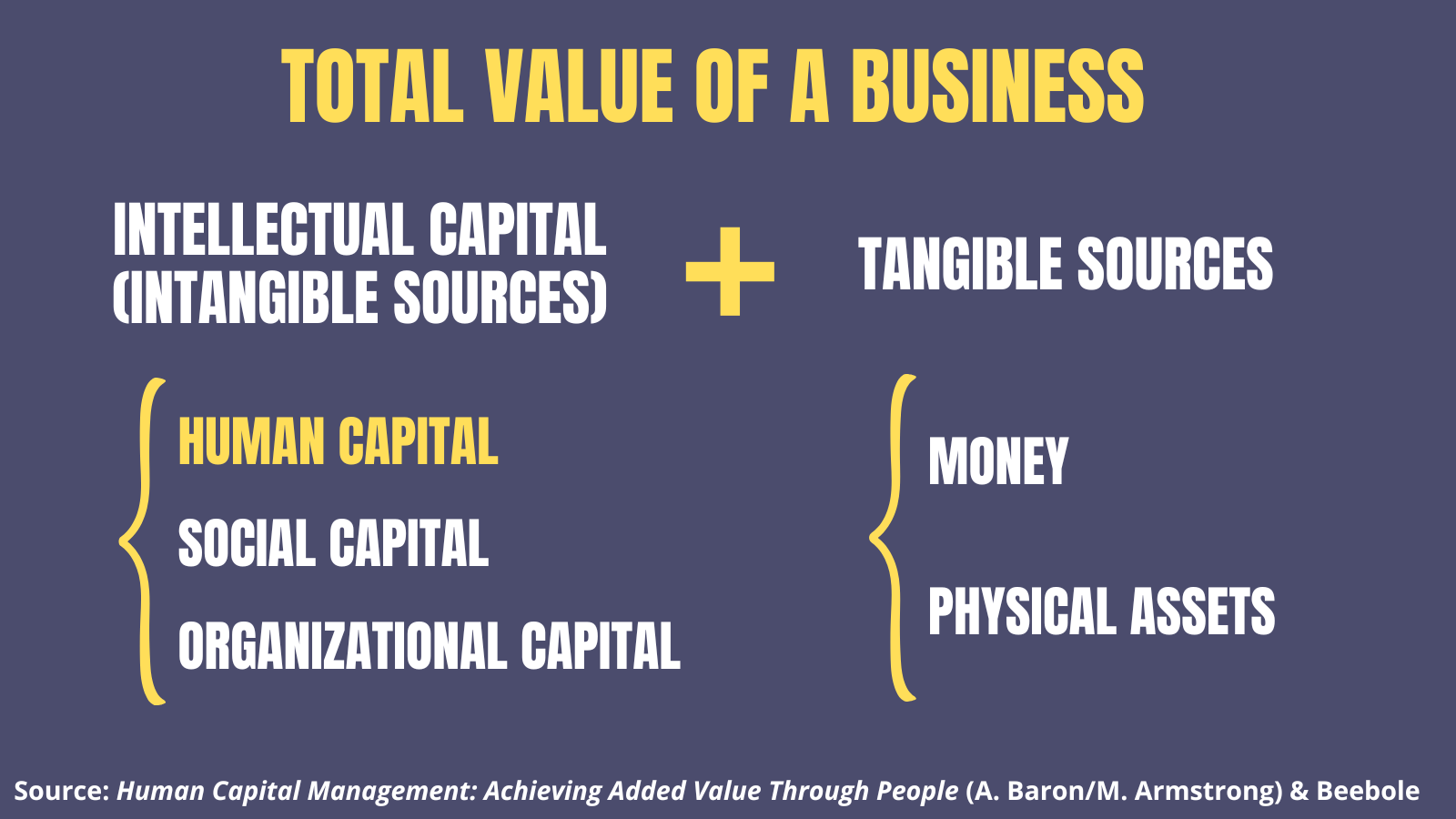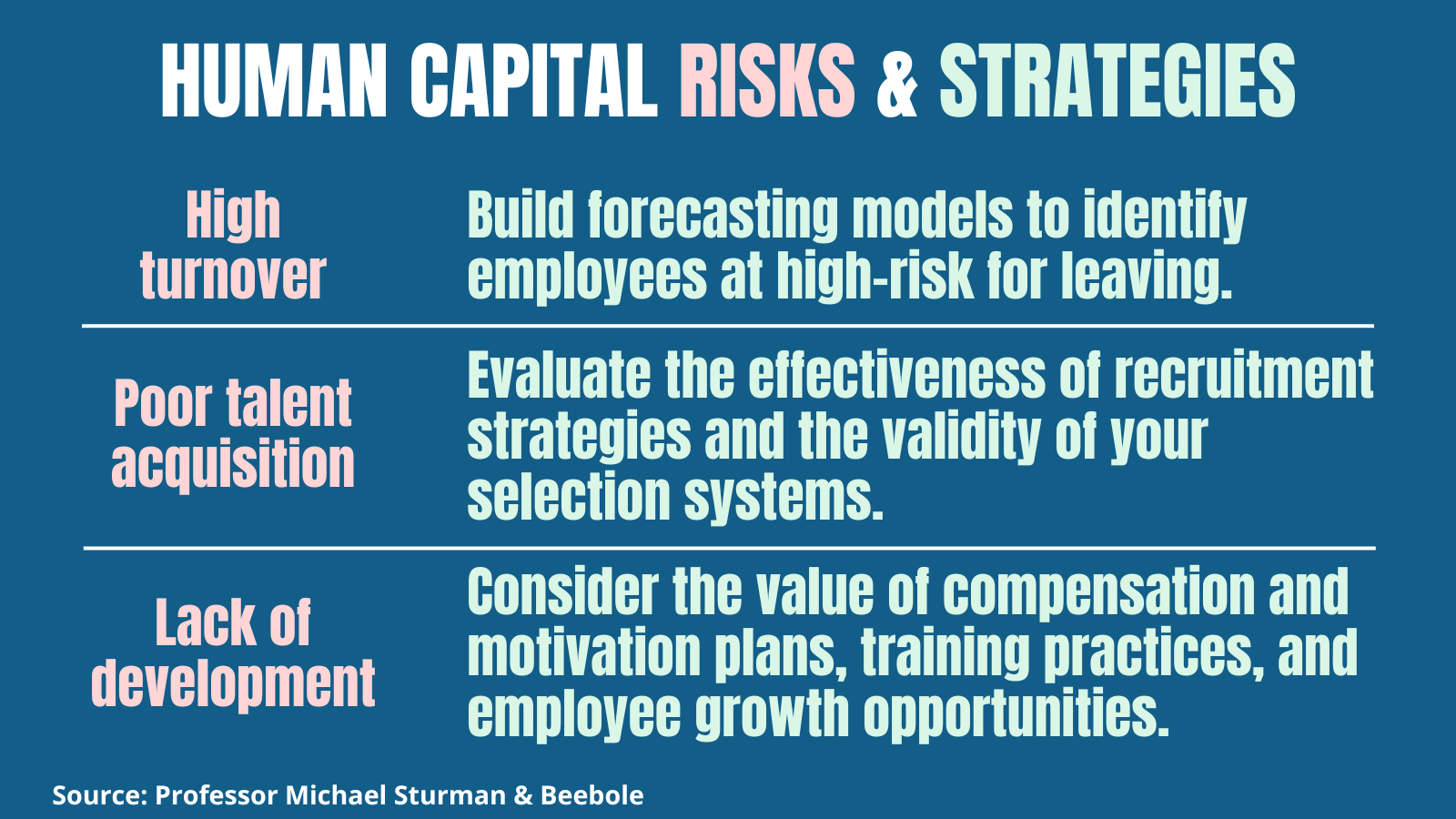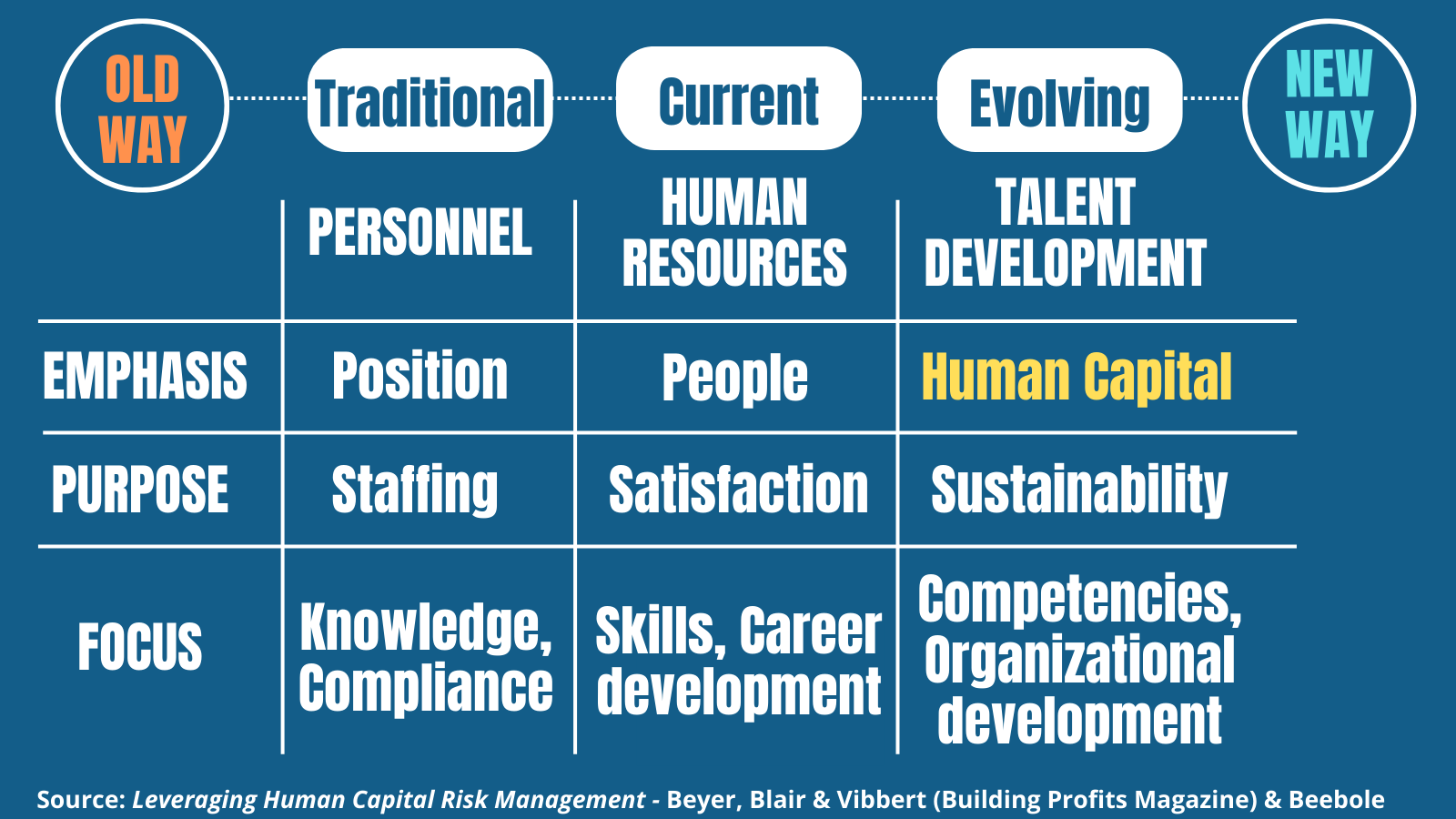Is your company doing this to manage human capital risks?


Table of Contents
Table of Contents
“Almost everything that can go wrong in a business has a human capital component.” David Creelman (CEO of Creelman Research). While most companies might agree, very few are prepared to manage human capital risks. Is yours one of them?
Regardless of how automated or technology-focused the current workplace is, the most valuable asset for any given organization is still the same: people! That’s why failing to properly manage human capital risks can hurt your business. The financial impact of these failures, as well as the price to pay at the brand, reputation, and energy level, are enormous.
Although most managers know this, only a small portion of companies have a clear strategy on human capital risk management. A Talentguard webinar on Mitigating Human Capital Risks highlights the following three prevalent features of such contradiction:
Do any of these sound familiar? Then keep reading for tips to help you build a solid human capital risk management strategy.
The umbrella covering human capital risks is broad. In fact, anything ranging from hiring the wrong people and failing to retain talent to unexpected accidents and inadequate attrition falls under that umbrella. That’s why our understanding of this matter begins with a brief definition of human capital.
In general terms, human capital is “a measure of the economic value of an employee’s skill set.” The term was coined in the 1960s by the economist Theodore Schultz. He believed that human capital was like any other capital. “It could be invested in through education, training, and enhanced benefits that lead to improvement in the quality and level of production.”
So an employee’s skill set can be treated as a contribution to the total value of a company. Let’s dig into this idea by taking a look at the framework that Angela Baron and Michael Armstrong provide in their book Human Capital Management: Achieving Added Value Through People:

According to Baron and Armstrong, human capital is one of the three elements that make up the intellectual capital of a company. This corresponds to the “stocks and flows of knowledge available to an organization.” The other two ingredients to consider are the social capital and the organizational capital.
In this context, human capital refers to the knowledge, skills and abilities possessed by people in a company. This is enhanced (or diminished) by the structure, networks, and procedures that define the interactions among them (social capital). That combination of human capital with social capital generates the organizational capital, which is the institutionalized knowledge possessed by the company.
Even if treated as an intangible asset, human capital has a very tangible impact on any organization. According to an article published in Deloitte’s Performance Magazine, the following are some of the areas where human capital can a have a significant impact on revenues and financial results:
Along those lines, an article published by the Harvard Law School Forum on Corporate Governance, highlights the value of human capital stating that “a company’s intangible assets, which include human capital and culture, are now estimated to comprise on average 52% of a company’s market value.”
With the disruption and uncertainty that prevails in today’s workplace, human capital management has become an imperative for companies willing to reach a competitive advantage in the market.
“Companies need to be able to attract, retain, and develop workers with the skills and expertise necessary to execute their long-term strategy and to deliver value creation,” argues BlackRock on a piece dealing with human capital management.
So, is it good to invest in human capital? Absolutely! Building a solid human capital management strategy is something crucial for any company not only in terms of the value it brings but also in terms of the costs and problems you can avoid.
“For leaders today, the act of aligning human capital strategy with business strategy is one of the most important things they can do to prepare strategically for the future of work,” argues Professor James Baron from the Yale School of Management.
Measuring an intangible asset such as human capital may sound complicated. However, there are some practical KPIs you can use to do that. After all, human capital is about people and the investment you make on your workforce. The following are some of the key measures that companies use to value human capital:

According to the Harvard Law School Forum on Corporate Governance article mentioned before, companies can track several things in order to use some of these key measures. The following are some of the most common across the corporate world:
If you’re able to track these things, you can identify critical issues and areas that can affect your organization. Now let’s take a closer look at some of the most significant human capital risks.
As we mentioned before, human capital can be treated as an investment. That’s why anything that interferes with the health of that investment is a risk. In this sense, human capital risks are events and employee behaviors that companies face when their human resources fail to meet operational, business resiliency, and continuity goals.
With this definition in mind, there are many human capital risks and numerous ways of categorizing them. However, some of the most prevalent human capital risks come from the following five critical areas mentioned by Velocity Global in an article dealing with human capital risk:
If they become real problems, some of the risks mentioned above can have devastating effects. For instance, when it comes to high turnover the Lowers Risk Group states that “companies typically pay between 25% and 250% of an employee’s annual salary to replace that employee.”
Likewise, poor human capital risk management can increase disengagement, deteriorate morale, affect productivity and hurt corporate reputation. According to an Accenture article on Human capital risk management, the following are some of the most serious implications associated with human capital risks:
There are plenty of reasons to incorporate human capital into your long term business strategy. While the benefits of a solid human capital management strategy are considerable, the drawbacks of a poor one can be fatal.
When it comes to building a human capital risk management strategy, there is one simple truth to consider: One size doesn’t fit all. All companies are different, and there’s more than one way to deal with human capital risks. Still, there are some basic steps any organization can take when dealing with human capital risks. Let’s take a look at some of them.
If you want to implement a successful human capital risk management strategy, you need to adapt it to your business. For that, you need to do two things:
“To mitigate human capital risk, you need to first determine what is the greatest threat you face. Whatever the risk may be, the first step is to understand the sort of risk you are facing in order to formulate solutions,” argues Michael Sturman, Professor of Human Resource Management in the Rutgers School of Management and Labor Relations.
Once that’s done, you can move into the implementation of potential solutions. “Once you know the type of risk or risks you are facing, you can begin to think about implementing the sort of best practices to mitigate, or at least manage the risk,” states Professor Sturman. In the following image, we can see some of those risks and the kinds of things companies can do to mitigate them.

Companies need to incorporate solid data analysis when managing human capital risks. As suggested in a Deloitte article published by The Wall Street Journal, HR should take advantage of all the data it collects in order to manage risks more effectively.
“Advanced analytics can provide deep insights about current risks and projections about future risks. Turnover data, for example, when combined with other information, may raise a red flag about hidden risks such as incompetent management or fraud,” states Deloitte.
Fortunately, the technological spectrum of tools that allow companies to track data is enormous nowadays. For instance, just having an employee timesheet report system that allows you to track things like time spent on projects, overtime, and time off, can help you identify potential red flags in terms of poor engagement, bad management, and even absenteeism patterns.
Tracking and interpreting data should play an important role in any human capital risk management strategy. The TalentGuard webinar recommends the following specific actions for companies wanting to gain deeper insights into human capital risk:
Similarly, Neil Roden, Group Director, Human Resources at The Royal Bank of Scotland Group, highlights the benefits that companies can obtain when they combine quality people data with business performance metrics.
“The use of quality people data is the key to good human capital management. Analyze and link this data with business performance metrics (such as sales, customer service, and financial performance) and you begin to get deep organizational insight into how effective your people strategy is and its impact on business performance and the bottom line,” argues Roden in the foreword of the Human Capital Management book we mentioned before.
A company that has successfully put that idea into practice is MetLife. According to MetLife’s executives Susan Podoglar, Laura Schubert, and Robin Gordon, the company spends a great deal of time using natural language processing to analyze qualitative data through employee comments.
“We pair the quantitative and qualitative survey results with other demographic and transactional data to develop a deeper understanding of populations across MetLife. We also use the data to understand where we may have risk or opportunities for improvement. The use of both types of data allows us to plan more localized and customized interventions—like developing a turnover model for our officer population,” explain Podoglar, Schubert, and Gordon.
Talent development is the most effective way of building a solid human capital strategy nowadays. In fact, human capital is at the core of modern HR strategies focused on competencies and organizational development.

Investing in your talent goes a long way in terms of managing human capital risks such as high turnover or dissatisfaction. In fact, some of the best talent development programs empower employees to achieve the following:
Talent development shouldn’t only matter to big organizations. Instead, it should be taken seriously by any company hoping to retain its best employees.
“Caring for the team once onboarded is essential. Attention to individual and team development and wellbeing, even with little budget for training and development, must be one of the organization’s priority. Research has shown that well executed individual development is rated by employees well above financial incentives such as bonuses,” argues Paula Conaghan, HR Director at One Family Foundation.
Understanding the cycle of your human capital is another key aspect to consider if you want to implement a human capital strategy centered on talent development.
As stated by Professor Sturman, “the best human resource practices are driven by first developing an understanding of the processes through which employees enter, develop, and leave the organization, and the value that employees’ human capital can bring. Understand where in the employee value chain you are hitting snags or obstacles. Then, work on that problem.”
Finally, it is also important to monitor your social capital carefully, especially when it comes to the relations that exist between your employees and their supervisors. According to Christopher Lee, Adjunct Associate Professor, Human Resource Management at the University of Richmond, “the biggest human capital risk of all, and one that is often discounted, is first-level supervisors or managers.”
Understanding this employee-supervisor relationship is key; We know that employees don’t leave bad organizations but rather bad bosses. “Turnover, disengagement, absenteeism, EEO problems and a host of other risks can be directly correlated with how employees feel about their work experience. Adequate training, support, and oversight of first-level people-managers is a wise investment at any and all times,” argues Professor Lee.
Managing human capital risks should be a top priority for any company. Although there’s no magical recipe or one-size-fits-all solution, choosing a strategy that fits your business, takes advantage of all your data, and is focused on talent development can provide you with a solid foundation for your human capital risk management process.
With everything learned today, let’s go back to our first question: Is your company ready to manage human capital? Do you have in place a clear strategy to deal with things like undesirable turnover, skill gaps, or leadership shortage? If your answer is no, then it is time to switch your corporate mindset and adopt a committed and proactive approach that allows your company to build a solid strategy for managing human capital risks.
Feel free to share your thoughts and comments below: any lessons learned (the easy or hard way)?
—
Image credit: Pixabay
When it comes to Human Resources demystification, no one does it quite like Suzanne Lucas aka the Evil HR Lady. Following our webinar on How to Make Remote Work Part of Your Team’s DNA, the HR expert, truth-teller and TEDx Talk speaker dives into her personal experience with remote work providing additional insights to the […]
What is Excel Power Query? Using Power Query in Microsoft Excel opens up the possibility of unlocking invaluable Business Intelligence for managers, which is exactly what we’re going to cover today. But first thing’s first: What is Power Query and where can you access it? You can access Power Query on the Data tab of […]
When it comes to working with data in Microsoft Excel, especially if it wasn’t your data to begin with, things can get tricky quickly. Between Excel formulas not working, human error, and simply trying to understand someone else’s thought process, there are a lot of ways checking and fixing an Excel workbook can go wrong. […]